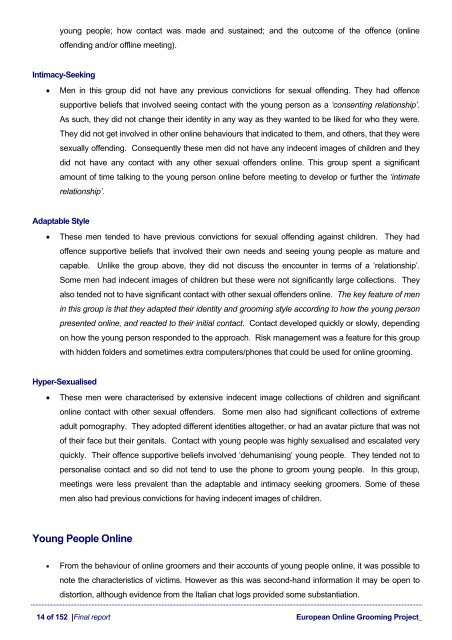Final Report - European Online Grooming Project
Final Report - European Online Grooming Project
Final Report - European Online Grooming Project
You also want an ePaper? Increase the reach of your titles
YUMPU automatically turns print PDFs into web optimized ePapers that Google loves.
young people; how contact was made and sustained; and the outcome of the offence (online<br />
offending and/or offline meeting).<br />
Intimacy-Seeking<br />
• Men in this group did not have any previous convictions for sexual offending. They had offence<br />
supportive beliefs that involved seeing contact with the young person as a ‘consenting relationship’.<br />
As such, they did not change their identity in any way as they wanted to be liked for who they were.<br />
They did not get involved in other online behaviours that indicated to them, and others, that they were<br />
sexually offending. Consequently these men did not have any indecent images of children and they<br />
did not have any contact with any other sexual offenders online. This group spent a significant<br />
amount of time talking to the young person online before meeting to develop or further the ‘intimate<br />
relationship’.<br />
Adaptable Style<br />
• These men tended to have previous convictions for sexual offending against children. They had<br />
offence supportive beliefs that involved their own needs and seeing young people as mature and<br />
capable. Unlike the group above, they did not discuss the encounter in terms of a ‘relationship’.<br />
Some men had indecent images of children but these were not significantly large collections. They<br />
also tended not to have significant contact with other sexual offenders online. The key feature of men<br />
in this group is that they adapted their identity and grooming style according to how the young person<br />
presented online, and reacted to their initial contact. Contact developed quickly or slowly, depending<br />
on how the young person responded to the approach. Risk management was a feature for this group<br />
with hidden folders and sometimes extra computers/phones that could be used for online grooming.<br />
Hyper-Sexualised<br />
• These men were characterised by extensive indecent image collections of children and significant<br />
online contact with other sexual offenders. Some men also had significant collections of extreme<br />
adult pornography. They adopted different identities altogether, or had an avatar picture that was not<br />
of their face but their genitals. Contact with young people was highly sexualised and escalated very<br />
quickly. Their offence supportive beliefs involved ‘dehumanising’ young people. They tended not to<br />
personalise contact and so did not tend to use the phone to groom young people. In this group,<br />
meetings were less prevalent than the adaptable and intimacy seeking groomers. Some of these<br />
men also had previous convictions for having indecent images of children.<br />
Young People <strong>Online</strong><br />
• From the behaviour of online groomers and their accounts of young people online, it was possible to<br />
note the characteristics of victims. However as this was second-hand information it may be open to<br />
distortion, although evidence from the Italian chat logs provided some substantiation.<br />
14 of 152 |<strong>Final</strong> report <strong>European</strong> <strong>Online</strong> <strong>Grooming</strong> <strong>Project</strong>_


